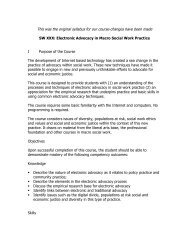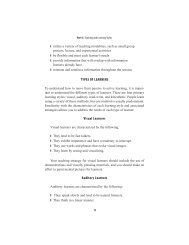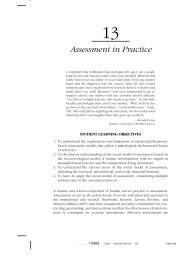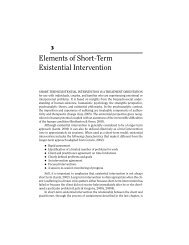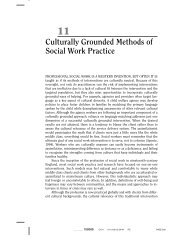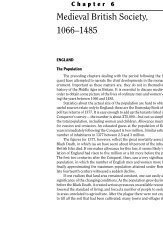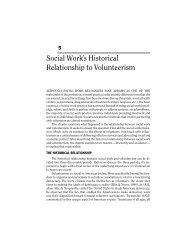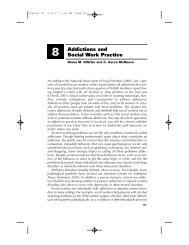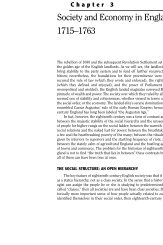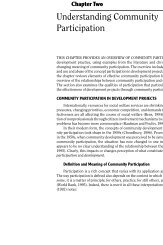Chapter 2 Self-Awareness, Critical Reflectivity, and ... - Lyceum Books
Chapter 2 Self-Awareness, Critical Reflectivity, and ... - Lyceum Books
Chapter 2 Self-Awareness, Critical Reflectivity, and ... - Lyceum Books
You also want an ePaper? Increase the reach of your titles
YUMPU automatically turns print PDFs into web optimized ePapers that Google loves.
<strong>Chapter</strong> 02 2/11/08 12:10 PM Page 29<br />
<strong>Self</strong>-<strong>Awareness</strong>, <strong>Critical</strong> <strong>Reflectivity</strong>, <strong>and</strong> Identity 29<br />
which white people experience privilege. People who are white know that<br />
they are white, but this is often translated as being just American.They do not<br />
have any experience underst<strong>and</strong>ing race <strong>and</strong> how it shapes our lives.They typically<br />
don’t think about their whiteness, nor do they think about the privilege<br />
bestowed on them because of their race.<br />
This inability or unwillingness to think of oneself in racial terms has decidedly<br />
negative consequences. For one thing, it produces huge blind spots. It<br />
leaves people who are white baffled by the amount of energy many African<br />
Americans <strong>and</strong> other people of color pour into questions of racial identity. It<br />
makes it difficult for white people to underst<strong>and</strong> why many people of color<br />
have a sense of group consciousness that influences the choices they make as<br />
individuals. It blinds them to the fact that their lives are shaped by race just as<br />
much as the lives of people of color. How white people view life’s possibilities,<br />
whom they regard as heroes,the extent to which they feel the country is theirs,<br />
<strong>and</strong> the extent to which that belief is reinforced by society—all of this, <strong>and</strong><br />
more, is a function of race.The internalized assumption of normality prevents<br />
them from imagining other possibilities.<br />
Skin color is a complex social indicator that promotes differential power<br />
<strong>and</strong> privilege between people who are seen as white <strong>and</strong> people of color (Pinderhughes,<br />
1989). One’s perception of reality is seldom questioned, except<br />
when one stumbles upon others who are different <strong>and</strong> have opposing worldviews.<br />
This conflict offers people who are white the opportunity to develop<br />
knowledge <strong>and</strong> awareness of themselves as racial beings. People who are white<br />
are generally unaware of ways to develop a racial identity <strong>and</strong> have few opportunities<br />
to underst<strong>and</strong> what it means to be white until they choose to embrace<br />
nonracist perspectives (Carter, 1995).White racial identity theory explains the<br />
developmental process that people who are white need to engage in to gain a<br />
better underst<strong>and</strong>ing of themselves <strong>and</strong> the environments in which they live.<br />
Exercises such as McIntosh’s (1990) “White Privilege: Unpacking the Invisible<br />
Knapsack,” a list of advantages that people with white skin experience in their<br />
daily lives <strong>and</strong> take for granted, can help individuals identify the ways in which<br />
they experience white privilege.These benefits range from being confident that<br />
one will not be discriminated against because of skin color in a job interview<br />
or when one tries to rent an apartment to seeing people of one’s own race represented<br />
on television. This exercise (which is available online) can advance<br />
racial identity awareness, but her work also has implications for underst<strong>and</strong>ing<br />
how various marginalized groups are disadvantaged. If one substitutes “people<br />
of my own sexual orientation” or “others with a disability” for “people of my<br />
race” <strong>and</strong> “people of my racial group” in most of the situations described by<br />
McIntosh (for example,“I can, if I wish, arrange to be in the company of people<br />
of my race most of the time” or “I am never asked to speak for all the people of<br />
my racial group”),then one can see how unearned privilege benefits those who<br />
are heterosexual or able-bodied <strong>and</strong> disadvantages people who are gay, lesbian,<br />
bisexual, or people who have a disability.



